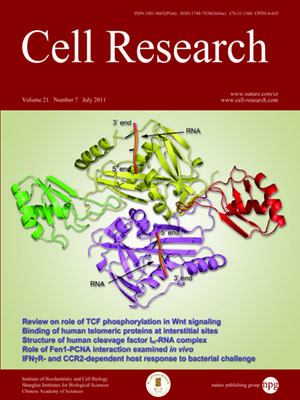
Volume 21, No 7, Jul 2011
ISSN: 1001-0602
EISSN: 1748-7838 2018
impact factor 17.848*
(Clarivate Analytics, 2019)
Volume 21 Issue 7, July 2011: 1028-1038
ORIGINAL ARTICLES
The human TTAGGG repeat factors 1 and 2 bind to a subset of interstitial telomeric sequences and satellite repeats
Thomas Simonet1, Laure-Emmanuelle Zaragosi2, Claude Philippe3, Kevin Lebrigand2, Clémentine Schouteden1, Adeline Augereau1,3, Serge Bauwens1, Jing Ye1,3, M
1Laboratoire de Biologie Mol閏ulaire de la Cellule-UMR 5239 CNRS/ENS Lyon/ Universit?Lyon, Ecole Normale Sup閞ieure de Lyon, 46 all閑 d'Italie, Lyon 69364, France
2CNRS and University of Nice Sophia Antipolis, Institut de Pharmacologie Mol閏ulaire et Cellulaire, 06560 Sophia Antipolis, France
3Laboratory of Biology and Pathology of Genomes of University of Nice Sophia-Antipolis, CNRS UMR6267/INSERM U998, Faculty of Medicine, Nice, France
4Dipartimento di Genetica e Microbiologia Adriano Buzzati-Traverso, Universit?di Pavia, Pavia, Italy
5Department of Medical Genetics, CHU of Nice, Nice, France
Correspondence: Eric Gilson,(Eric.Gilson@unice.fr)
The study of the proteins that bind to telomeric DNA in mammals has provided a deep understanding of the mechanisms involved in chromosome-end protection. However, very little is known on the binding of these proteins to nontelomeric DNA sequences. The TTAGGG DNA repeat proteins 1 and 2 (TRF1 and TRF2) bind to mammalian telomeres as part of the shelterin complex and are essential for maintaining chromosome end stability. In this study, we combined chromatin immunoprecipitation with high-throughput sequencing to map at high sensitivity and resolution the human chromosomal sites to which TRF1 and TRF2 bind. While most of the identified sequences correspond to telomeric regions, we showed that these two proteins also bind to extratelomeric sites. The vast majority of these extratelomeric sites contains interstitial telomeric sequences (or ITSs). However, we also identified non-ITS sites, which correspond to centromeric and pericentromeric satellite DNA. Interestingly, the TRF-binding sites are often located in the proximity of genes or within introns. We propose that TRF1 and TRF2 couple the functional state of telomeres to the long-range organization of chromosomes and gene regulation networks by binding to extratelomeric sequences.
Cell Research (2011) 21:1028-1038. doi:10.1038/cr.2011.40; published online 22 March 2011
FULL TEXT | PDF
Browse 2072


